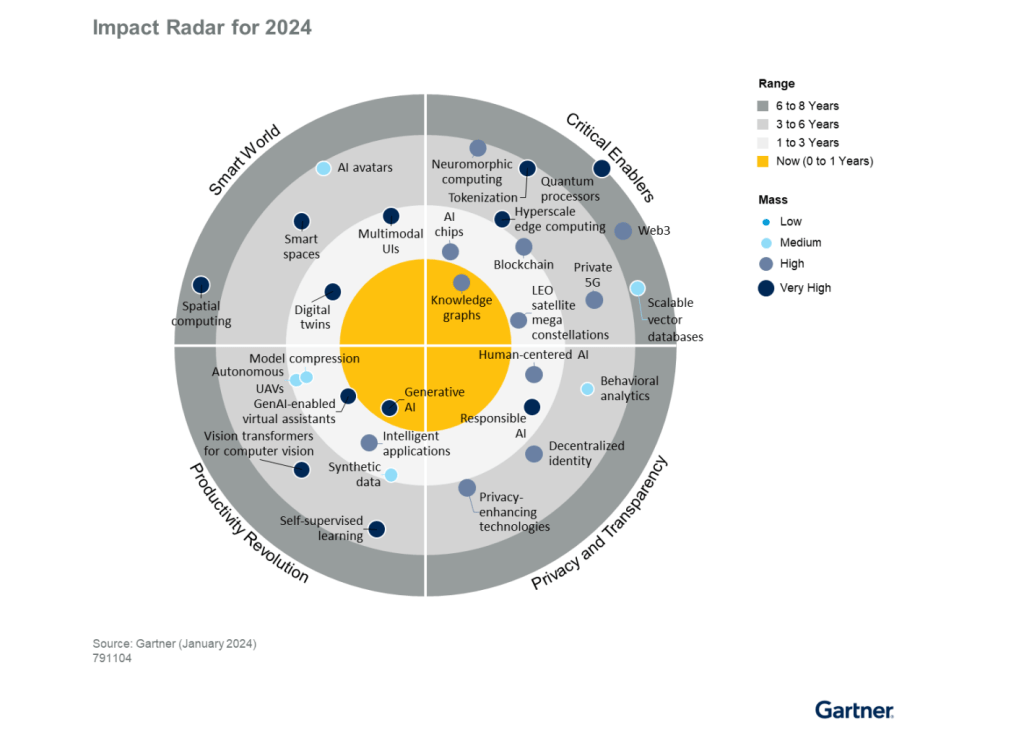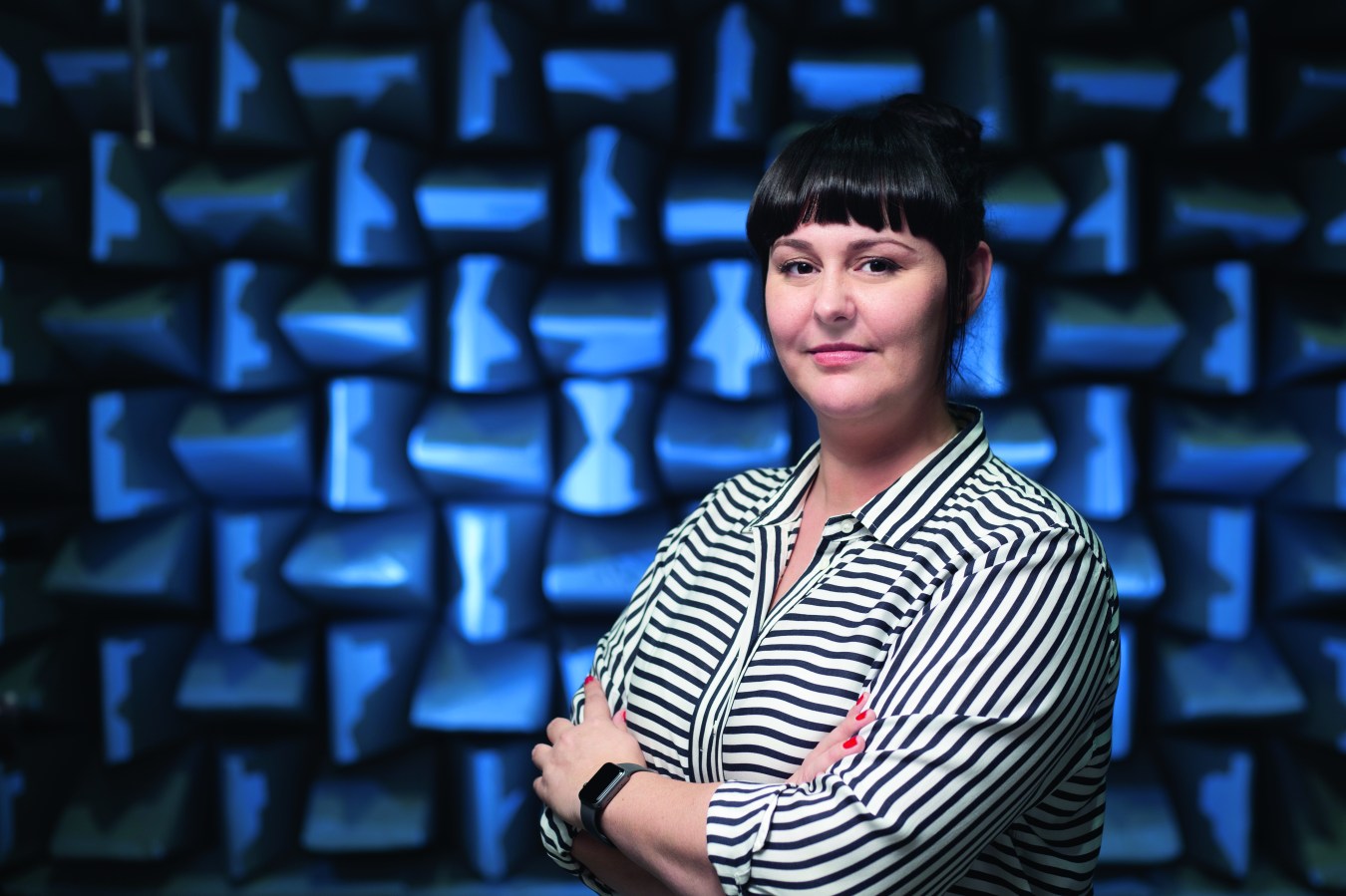Gen AI and knowledge graphs are the most impactful emerging technologies right now. By 2030, it will be quantum processors, scalable vector databases, and spatial computing, according to Gartner. Here’s what you need to know about the emerging tech on the horizon.

The 2024 Emerging Tech Impact Radar is out, and it is no surprise which technology is making the most impact this year. Gen AI continues its domination of headlines, earnings calls, and strategic plans.
Looking forward, one of the emerging technologies that will have the most impact is spatial computing, according to Gartner. The fusion of the real and digital world through devices such as augmented reality is only six years away.
Critical enablers
Powering spatial computing and other emerging technologies will be quantum processors, defined as “chips that consist of qubits, or quantum bits — the counterpart to the bits in classical computing.”
Key to understanding quantum processors, is the term ‘superposition.’
“Unlike bits in classical computers, a qubit can exist in a state of superposition, where it is a hybrid state of zero and one at the same time until it is observed,” the Gartner report reads.
Gartner classifies quantum technology, as well as web3 and scalable vector databases, as ‘critical enablers’ of the technological future ahead of us.
“Knowledge graphs and scalable vector databases are key software enablers. These technologies are supporting generative AI adoption by improving the explainability and utility of LLM implementations within the organization. Investment in these technologies
will be important for GenAI adoption,” according to Gartner.
Between 2025 to 2030, the 12 categories of emerging tech that will have the highest adoption are:
- GenAI-enabled virtual assistants
- Multimodal UIs
- Responsible AI
- Digital twins
- Smart spaces
- Hyperscale edge computing
- Quantum processors
- Self-supervised learning
- Vision transformers for computer vision
- Tokenisation
- Spatial computing
- Quantum processors
The report found four themes that help to understand the emerging technology that is ahead of us: the world will become increasingly ‘smart’, there are critical enablers that will facilitate that transformation, there will be a revolution in productivity, and an increasing need to prioritise privacy and transparency.

The sector that has the highest concentration of emerging technology between now and the 2030s, is critical enablers, suggesting that a further acceleration of innovation is on the other side of the creation of the enabling technology.
“Advances in AI hardware (such as AI chips, neuromorphic computing and quantum
processing) are and will continue supporting the deployment of AI solutions on more embedded edges, as well as supporting more complex AI applications to run outside of the cloud.”
Spatial computing
Gartner defines spatial computing as an ‘environment that combines physical and digital objects in a shared frame of reference.’
The world that is created “involves spatial mapping and identification of people, places and things within the physical world — as a foundation for anchoring digital content that intersects with the physical world’s spatially anchored, indexed and organized content,” according to the report.
If building a multi-spatial environment for your business to operate in sounds like a lot of work and you don’t know where to start, look to vendors that already have this technology: Meta, Magic Leap, Microsoft, Apple, NavVis, Resight and Niantic.
The reason this emerging technology will have a high adoption rate in the 2030s, is because it will change how people interact with their environment, merging the physical world and the digital world together. It will be particularly useful in a world where we work-from-anywhere.
“In an environment where remote working and workforce globalization are becoming more
popular, there is much opportunity for spatial computing in the communication and
collaboration space.”
This next frontier will be accessed through something similar to the internet that we use now.

“Spatial computing will be experienced via the spatial web — which is an analog to the World Wide Web.”
An example that can help to explain the next chapter in computing, is the way search will be done.
“To identify a plant, instead of using a phone to search based on location, colour, size, shape and season, users can look at it through a digital lens of a phone, tablet or HMD and instantly identify what they’re looking at — the equivalent of a digital name tag or post-it note. Spatial computing will enable this for the user’s environment.”
How to get ready for these technologies
To prepare for spatial computing and other emerging technologies, the Gartner report recommends that businesses use these four steps:
Enhance competitive differentiation in the smart world
Work within an ecosystem of partners to deliver the types of interactions that bring value based on your specific use cases and target markets. This could be a combination of AI avatars, multimodal UIs and spatial computing.
Prioritise the most prevalent and impactful generative AI use cases
Conversational AI, content creation and simulation — these already deliver real value to users.
Stimulate growth while mitigating risk and restrictive regulation Building user trust via systems such as decentralized identity and behavioural analytics and applying human-centred AI and responsible AI principles.
Support your strategic product roadmap Identify relevant emerging technologies, business values and relevant tech partners that your roadmap can enable.
it may also be helpful to think about how you want your business to be positioned in the future. Is the company strategy to be a first-mover, a fast follower, a majority follower, or a laggard?
‘First movers’ should be taking action now to meet the 6-year emergence of spatial computing and other technologies.
Companies that are ‘fast followers’ should now be looking at the technologies listed in the 3-6 year category below.
Organisations that integrate emerging technology at the same time as others should be investing in tech in the Now and 1-3 years columns.
| Now | 1 to 3 years | 3 to 6 years | 6 to 8 years | |
| Generative AI | AI chips | AI avatars | Quantum processors | |
| Knowledge graphs | Autonomous UAVs | Behavioural analytics | Scalable vector databases | |
| Digital twins | Blockchain | Self-supervised learning | ||
| Gen-AI enabled virtual assistants | Decentralised identity | Spatial computing | ||
| Human centered-AI | Hyperscale edge computing | Web3 | ||
| Intelligent applications | Neuromorphic computing | |||
| LEO satellite mega constellations | Privacy-enhancing technologies | |||
| Model compression | Private 5G | |||
| Multimodal UIs | Smart spaces | |||
| Responsible AI | Tokenisation | |||
| Synthetic data | Vision transformers for computer vision |
Look back on the week that was with hand-picked articles from Australia and around the world. Sign up to the Forbes Australia newsletter here.


